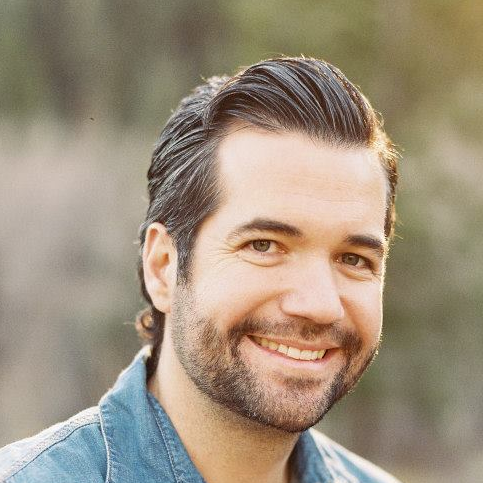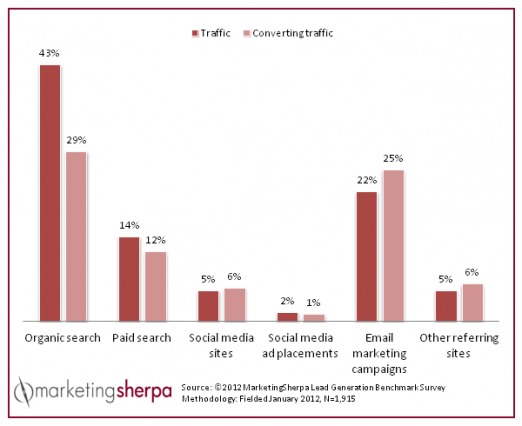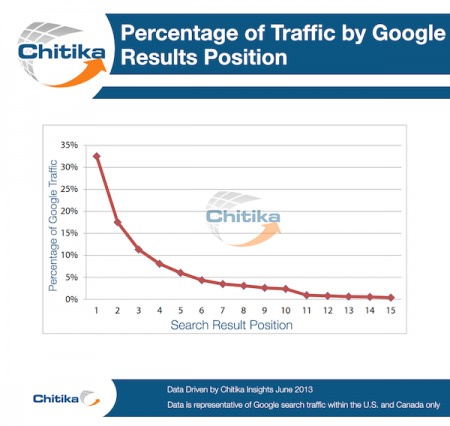You’d think conversion optimization and SEO should play together nicely, right?
In theory, conversion optimization aims to improve the user experience, which, conveniently, is what Google wants to do as well with their top search results. Therefore, the more you test and improve your site, the higher it should appear in the rankings. You get more traffic, more conversions, more money – in an endless hockey stick shaped cycle.
Of course, it’s not so simple.
There are issues that I’ve heard marketers bring up where there can be a conflict between CRO and SEO. In addition, in silo’d teams or with limited budgets, there can be tradeoffs and decisions to be made between investing in CRO or SEO. Finally, a lot depends on execution – how you test and optimize your website matters.
I talked to people who have years of experience in growth, SEO, and optimization to figure out where the intersection is between CRO and SEO. How do you balance traffic acquisition with conversion optimization?
Table of contents
CRO and SEO: The Perfect Couple?
CRO and SEO should work together perfectly. There shouldn’t be a conflict.
It’s in Google’s self interest to provide the best search experience for the user. So they update their algorithms religiously to try to do that. And recent trends have placed on page UX factors higher in importance that old factors like keyword density. When an optimizer increases the page speed, that generally helps search rankings as well, because people like fast pages and Google knows this contributes to a better experience.
CRO, in most cases, doesn’t conflict with SEO; rather they complement each other.
The classic example of this is the question of whether to write for humans or for Google bots. Well, as Google’s algorithms have advanced, the two end up being quite the same. Keyword stuffing thankfully becomes ridiculous in the eyes of Google (as well as the reader) and you should write for the humans that are buying the stuff you’re selling.
Even if you look at it from a high level, there shouldn’t be an inherent conflict between SEO and testing. Google has its own testing tool. Google runs A/B tests. Why would they penalize what they not only do but offer as a service?
Google Doesn’t Want to Penalize Better UX
Okay, so there’s the intuitive argument that SEO and CRO should get along. Still a lot of marketers don’t believe it – or they’re at least skeptical about some of the technical aspects of testing and SEO.
Paras Chopra, founder of VWO, answered a question about this on Quora. According to him there’s no impact of A/B testing on SEO:

Paras Chopra:
Google itself does A/B testing and has a tool for A/B testing, so one would assume they are fully aware that other companies do A/B testing as well.
So, Google (and other search engines) are highly unlikely to penalize for A/B testing. As a precaution, you may want to filter out search bots from your tests (but that’s not really necessary as most search bots will see your original page only, not the variation).”
Basically, there’s no reason to worry that A/B testing will mess up your coveted rankings. Especially if you’re following some clear and simple rules…
Follow Google’s “Rules” For Testing
It’s not as common as it used to be, but people use to worry a lot about A/B testing ruining rankings. What they worried about, generally, were these four things:
- Content cloaking
- URL and content duplication
- Wrong kind of redirect
- Web loading concerns
First, running A/B tests that dynamically swap elements via javascript is not content cloaking. Content cloaking was a popular and effective SEO tactic in the 1990s, when people would create a variation that was stuffed with a ton of keywords to show to the Google bot. They would then present a different, more user-friendly version to the actual visitors. If you’re running tests, this really isn’t a concern, as Google expects you to be providing dynamic experiences.
Second, content duplication shouldn’t be a concern either. As Paras Chopra put it in an article from few years ago:

Paras Chopra:
“An important point to note here is that search engines only penalize if you steal or host content from a different domain; here all variations pages host on your own site and you OWN that content and are free to do with it whatever you want to.
Many dynamic websites (shopping carts, directories, etc.) today host the same content in different formats. Search engines don’t penalize them because that unique content is only found on their domain and no where else. Same is the case with your split testing URLs. You don’t get negatively impacted by it because you haven’t stolen that content — it is all yours!”
If you’re worried, you can use a canonical tag.
Third, just avoid 301 (permanent) redirects. Use 302 instead.
Finally, page speed. This is the only real concern, but it still shouldn’t be an issue in most cases.
In summary, testing is fine, even encouraged, but you just have to follow some basic rules:
- No cloaking.
- Use rel=“canonical”.
- Use 302s, not 301s.
- Only run the experiment as long as necessary.
Does it matter whether you’re running client-side or server-side experiments? According to Matt Cutts, no. On a HackerNews thread a few years ago he said, “You can do A/B testing via either server-side or client-side technology. In both cases, don’t do anything special or different for Googlebot. Treat Googlebot just like any other user and don’t hard-code our user-agent or IP address.”
Anything else, just read this official statement from Google on A/B testing. There’s really not much to worry about if you follow some simple rules.
Traffic Without Conversions is Worthless
You know all about vanity metrics, and how you shouldn’t be obsessed with them.
Twitter followers, downloads, page views – they mean nothing if people aren’t converting and paying you.
So there are the cases where SEO isn’t as meaningful and you should be focusing on higher impact areas, such as optimizing your current traffic.
For example, if the keywords you’re ranking for are super irrelevant to your value proposition, there’s an inherent mismatch that will be hard to optimize, at least on page. You can usually tell this is the case when your SEO traffic converts well below other acquisition channels. If you’re running tests and getting lifts everywhere else but organic, your keywords aren’t high intent.
Now, irrelevant traffic isn’t necessarily a bad thing. It’s not hurting your revenue. But it shouldn’t be a roadblock for increasing revenue per visitor via running tests.
Also note that often, organic traffic is one of the highest converting channels. Due to Google’s increasingly sophisticated algorithms, intent and match are usually pretty high.
Where’s The Conflict, Then?
What happens when you fall out of Google’s Number One Spot? It can be quite detrimental to growth. Considering position #1 has been shown to get 33% of traffic, you can lose a lot of potential customers
Now, as we’ve seen, there aren’t supposed to be conflicts between SEO and CRO. But, in reality, do conflicts ever exist. I asked Rand Fishkin, and he said only sometimes does that occur…

Rand Fishkin:
“Yes, but only barely. For SEO, using keywords and language on a page intelligently and in ways that match with how people search (e.g. using “Rand’s Bookcases” instead of “Make Your Book Storage Problems Disappear” is generally advisable) still matters quite a bit.
Sometimes, a CRO test will reveal that less obvious, direct language use actually converts better, which can make for a sacrifice. That said, in 90%+ of cases I’ve seen, there are easy ways to compromise a little and find a great balance (e.g. “Rand’s Bookcases Make Your Book Storage Problems Disappear”).”
For a real world example, take LawnStarter Lawn Care. They get a lot of SEO traffic for people searching for local lawn care companies, so losing any traction on Google is quite detrimental to their acquisition. Could they A/B test a more benefits driven value proposition? Yes, but there are certain keywords that have to remain in the H1 tag, so there’s the realistic prospect of losing traffic if they change it out for a clearer, benefit driven headline.
Ryan Farley, co-founder of LawnStarter Lawn Care, told me that, while Google’s algorithm may be progressing in certain ways, it’s still not perfectly aligned with the best user experience…

Ryan Farley:
“There’s this theme going around the SEO community that SEO is really about creating the best possible website for your visitors. If that is true, than SEO and CRO should be aligned. In practice, it doesn’t really work that way.
The reality is that Google’s algorithm still relies heavily on non-UX signals, one of them being having the keywords in H1s, body text, etc. If you don’t have your keyword in the H1, well, you’re going to miss out on SEO. Otherwise, the algorithm can’t properly categorize your page.
For example, if you go to our Jacksonville page, there’s no way our headline can’t have the words “lawn service” and “Jacksonville” in them, even though with Ads we’ve found better converting headlines.
You have to do the math between what you’ll get from the ranking boost vs what you’ll lose in conversion.”
With a myopic focus on conversion rate optimization, it’s hard to balance these and make an informed decision. For example, if the increase in traffic volume and conversion volume from ranking higher has a better revenue than a version with a higher conversion rate, it’s pretty obvious you should go with the higher revenue version.
As Himanshu Sharma from Optimize Smart said, “In order to truly optimize revenue you need to focus on increasing average order value and number of transactions for each of your market segment, product categories and other portfolios of outcomes.”
But, you know, you shouldn’t be optimizing for conversion rate anyway.
Still, as Rand mentioned, there’s almost always (90%+ of cases) an easy way to compromise. It’s not “this-vs-that” as much as it is a need to think creatively and satisfy both the search engines and your customers.
Missing Test Assets
Here’s an actual concern: if you’re running tests on elements that get a lot of SEO traffic, and you delete them (as you would) when you implement the new version, you risk losing traffic.
A guest writer on Moz’s blog put it this way:
“From an SEO perspective, when you delete an image of my face that was outperformed by a cute model, you create a void for Google. If Google tries to rescan an asset you deleted, your servers produces a 404 error telling Google the page, image, or video does not exist.
That product image you tested may show up number one in Google’s image results to bring you 100 visitors per month. Remove the image and Google will remove it from the search results causing you to miss the 100 uniques (and probably decent sales because the visitor is searching for the product).
I like to keep most test assets (videos, images, and audio) alive for these reasons. The only exceptions are unique pages setup solely for a test, which I delete then 301 redirect back to the control. We don’t want Google paying attention to these test pages remember. The deletion is more from my OCD for a clean system rather than a strategic purpose. As long as you canonicalize and use noindex, you’re fine.”
Again, it’s important to keep your test assets, at least in the case of archiving and learning. But for SEO purposes, canonicalize and use noindex and you’ve got nothin’ to worry about.
When Product Reviews Hurt Conversions
Here’s an issue I would never even have thought about: reviews. Luiz Centenaro from Experiment Engine explained to be that there can be a conflict here sometimes…

Luiz Centenaro:
“Lastly something not many people have discussed are product reviews, they are always said to be great for SEO and CRO but what if you tested multiple variations on your PDP (Product Detail Pages) and the winning variation was an existence test removing reviews and social proof, which significantly increased conversions and RPV (Revenue Per Visitor)
Would you implement that or risk losing schema markup and other SEO benefits of having ratings?
What if you had 30+ reviews with rich content that brought you thousands of visits a month but decreased conversions by 10%. Would you implement the winning variation?
The answer is unique to each eCommerce store but if you rely on SEO traffic you probably won’t implement the winning variation removing product reviews.”
Though, in this case I want to say that it’s a matter of execution. If reviews are lowing your conversions because you have terrible reviews – well, fix the shit that’s wrong and get better reviews. Right? Use it as a valuable form of qualitative data.
And if, for some reason, they are serving as a distraction, then you need to implement them better. There are a million ways to use testimonials to increase conversions.
A Balancing Act
Benjamin Beck, Growth at RoverPass, is well-versed in both conversion optimization and SEO. In his past, he worked at larger companies with more silo’d approaches to marketer, and found there could be a little bit of a tradeoff or a balancing act to maximize long term growth. How he put it…

Benjamin Beck:
“Usually SEO & CRO are the 1-2 punch to helping companies succeed. SEO brings in free traffic without an exact cost, and CRO converts them.
There needs to be a good balance between SEO & CRO. If you focus too much on one, it can drastically hurt the other.
How if you focus too much on CRO, it may hurt your SEO:
- Focusing on conversion so you much that you don’t get the value unless they convert. For example, gating a valuable report unless they fill out a form. It’s hard to rank a form organically if it doesn’t have any value on the page itself.
- Not including the main keywords on the page, especially in the Title or URL.
How if you focus too much on SEO, it may hurt CRO:
- Trying to stuff keywords into the content. Robots don’t buy your product, write the copy so it converts humans.
- Including links so that users leave the page instead of converting,”
How Can CRO and SEO Work Together?
Clearly, there are ways for the one-two punch of CRO and SEO to work together, even in large, segmented organizations. Benjamin Beck, who has worked at large and small companies and as a consultant, gives his experience with how things are usually set up…

Benjamin Beck:
“In my experience with companies they usually are set up into departments that are in charge of either traffic OR conversion. Usually not both.
- SEO – Goal is traffic
- Social – Goal is traffic
- Content – Goal is traffic
- Email – Goal is conversions
- PPC – Goal is traffic & conversions (Focus on ROI for conversion)”
Okay, so teams are usually segmented by goal. But is that a good or a bad thing for overall growth? Are there conflicts of interest that arise?

Benjamin Beck:
“I don’t think it’s a good idea or necessary a conflict of interest… but it’s just hard to track and attribute conversions.
PPC usually has isolated landing pages and you can turn it on / off so it’s easy to track and attribute.
Social, Email, SEO, etc can all play into a conversion but it becomes a question of attribution which can vary vastly depending on the company.
For RoverPass, Facebook sends a lot of people but they don’t “convert.” But we get their email & pixel them so that they convert in the future. But we still need to attribute part of it to social (Facebook communities)”
Outside of segmented teams, SEO and CRO working together is really not hard to imagine. After all, we’ve seen they usually help each other out. It’s important then, not to neglect one or the other. As Rand put it…

Rand Fishkin:
“SEO is still one of the biggest traffic drivers on the web (~28% of all web traffic referrals come via search according to SimilarWeb), and as such, it’s essential for those seeking to earn visits that they perform well in search. CRO can actually help a lot here, because Google cares deeply about a positive user experience and successful queries, which CRO can help drive. Basically, it’s about earning visitors through search, and converting them successfully with CRO.”
By the way, if your SEO and conversion optimization teams actually, you know, communicate, you can break down some barriers and really accomplish things on both fronts. For example, V9SEO explained how they use the 3 main search queries to help with conversion optimization…
“As an SEO, I’m all about queries. There are three main types of queries, each backed by a particular user intent:
- Navigational query – searching for the name of a website. Intent: to get to a specific website.
- Informational query – searching for information on a given topic. Intent: to learn about something.
- Transactional query – searching for a product or service to purchase. Intent: to buy.
Those three types of queries affect conversion optimization. A conversion optimizer must understand the intent of the user who is landing on a certain page, to know 1) what conversion action would be most appropriate, 2) what conversion action is most likely to elicit a conversion, and 3) the best method of persuading the user to convert.”
CRO and SEO are linked in many ways. Bridging the gap between divided teams and sharing data such as the above help both marketing techniques thrive.
The Future of SEO and CRO
This article, by nature, is ephemeral. Google’s algorithms are constantly updating, so it’s possible that in 2 years (or 2 months), much of the issues raised above won’t exist. It’s also possible that a slew of new issues will arise.
But even the current state of SEO and optimization is pretty optimistic. When I asked Rand Fishkin about how SEO and CRO can complement each other, he said they absolutely can do that:

Rand Fishkin:
“CRO helps identify poor messaging, bad usability, bad user experiences, and/or UX missteps. Those things all help you to provide a better experience for searchers, which search engines reward. It’s a wonderful cycle of mutual benefit.”
As for predicting the future, I’m no clairvoyant. Despite hundreds of articles being published each year with new predictions for various industries, it’s impossible for anyone to predict with any certainty where things will go.
That said, there are certain things today that indicate a change in the general direction of what’s been referred to as “search experience optimization.”
This broadly means that SEO and CRO will clash less and less, and what’s good for one will benefit the other. Benjamin Beck actually sees things headed that direction as well. He also believes the future will bring an increased investment in conversion optimization because saturation is making SEO a crowded and timely/expensive channel…

Benjamin Beck:
“I see that SEO & CRO will continue to grow closer together.
SEO is usually seen as “free traffic,” but the time and cost to get those rankings and traffic can be a lot. As SEO continues to become more competitive I believe it will become more like PPC where you the cost needs to be offset by conversions.
So I believe companies will start investing a lot more into CRO to get even more value out of pages that gain a lot of organic traffic.”
Search Experience Optimization
Mike Templeman, writing for Forbes this February, said that the era of search engine optimization is over. What’s risen to replace it, also with the SEO acronym, is ‘search experience optimization.’ Why? As he said:

Mike Templeman:
“Instead the search engines have started to write logic and incorporate machine learning algorithms that based on vast troves of user behavior metrics, to their best estimation, is what a user experience should be on a website.
Some of the criteria they are now measuring are site speed, mobile optimization, site structure, content, and dozens of other signals that should give the algorithm an idea of whether or not search engine users are getting what they expect from a website.”
His suggestions for the future include “asking questions, and providing answers” and “embracing mobile.” The implications are great for the customer experience in general. The example he gave was that the search term “snow tires” has evolved into, “what are the best snow tires for a 2008 Ford F150?”
Therefore, the companies that answer questions for their customers are winning search rankings. This, in general, implies that you should stop worrying about the number of times you mention your keyword and focus more on helping your customers find what they’re looking for.
Conclusion
Conversion optimization and search engine optimization, while not completely aligned at all times, are by no means enemies. In fact, investing in conversion optimization should and often does increase rankings. Likewise, a strategic approach to SEO increases conversion volume and target visitors.
The few issues that remain – keywords in H1 tags, reviews that hurt conversions but help SEO, and missing test elements – are all easy to overcome. In addition, there’s no rational reason to fear that A/B testing will hurt your SEO. Rather, it’s encouraged by Google to provide a better user experience (which is what they’re looking to deliver, too).
The biggest hurdles, as usual, appear to be organizational. Teams with disparate goals and a lack of communication cannot fail to fall short of their potential. Focus on a collaborate approach to growth optimization and you’ll flourish, both in conversions and SEO acquisition.







Hi Alex, thanks for writing about a topic that I think not enough people are talking about!
Thanks for contributing your opinion and experience, Ben!
Hi Alex,
Thanks for the write up.
Quick add-on to the discussion:
* Make sure search engine bots can see your test page
* Make sure the canonical tag points to _original_ page
* Add the meta robots “Noindex” directive to prevent google from indexing the page
I have seen a few clients using loadbalancing to test traffic to a new site redesign or a new domain.
In one case we had a test running for several months while the tech team was fixing usability bugs discovered on the new site.
We had a bit of perfect storm to ruin our traffic:
* New design and setup is rushed before peak period
* 50% traffic is sent to pre-production subdomain,
* Subdomain is blocked by robots.txt
* Canonical tags are self referring (aka test.example.com/urlA instead of http://www.example.com/urlA)
* Team too busy fixing bugs or change canonical tags so we are stuck with situation
Thanks to this poorly implemented setup, we lost quite a bit of traffic during the test and for at least another 4 weeks. The loss was in the 6 figure range. Monthly performance meeting was fun…
So again,
When doing loadbalancing, make sure you use rel=“canonical” to the original page and don’t block bots via Robots.txt. Add the robots “noindex” directive at a page to clear state to Google that the test page should not be included in their index.
We had 2 months of
Use 302s, not 301s.
Only run the experiment as long as necessary.
Fantastically written and well researched article Alex. Thanks for including me in such great company. SEO & CRO are 2 industries so many people fail to recognize are constantly evolving. Peep said it best in an AMA on Test & Tell, “CRO Has a 2.5 year half life” You have to relearn everything every 2 years to stay fresh. With SEO and CRO earning a bigger chunk of marketing budgets it makes sense to learn how the 2 digital marketing channels can work in harmony.
Thanks Luiz, and thanks for contributing your opinion and experience
Nice article, but there’s a mistype when you mentioned the redirect. 302 is not a permanent!
thanks for the heads up, just fixed it!
Thank you for the post, Alex. Definitely some food for thought…
“For example, if the keywords you’re ranking for are super irrelevant to your value proposition, there’s an inherent mismatch that will be hard to optimize, at least on page.”
This is a problem I had to deal with a couple of times. I’ve seen people optimize websites for niche-specific keywords, instead of focusing on product-specific definitions. In the end they get traffic, which doesn’t convert and want you to magically do something about it.
Somehow, some of the business owners think that all you need is traffic, any traffic…and you can magically make it work for their business. When in reality, people who never had the intent to purchase (convert) are visiting info pages that they immediately abandon, without any interest in the product that you offer. This is where the bond between CRO and SEO should be pretty strong – planning the right keywords in advance will make your CRO a lot easier in the future.
Hey Alex, thanks for the comment and totally agree. This, I think, is where some organization work comes into play. Instead of solely incentivizing SEO teams on traffic and conversion teams on conversion rates, it makes sense for them to work together to get a ton of traffic that converts really well. That is definitely where the bond between CRO and SEO is strongest.
It is really a great boon for both of them to understand well between them and to work efficiently with out any cons. thanks
Indeed, the tricky part is balancing the teams’ goals. Thanks for the comment!
it is a nice post.I read and is very interesting.It is very useful for me.